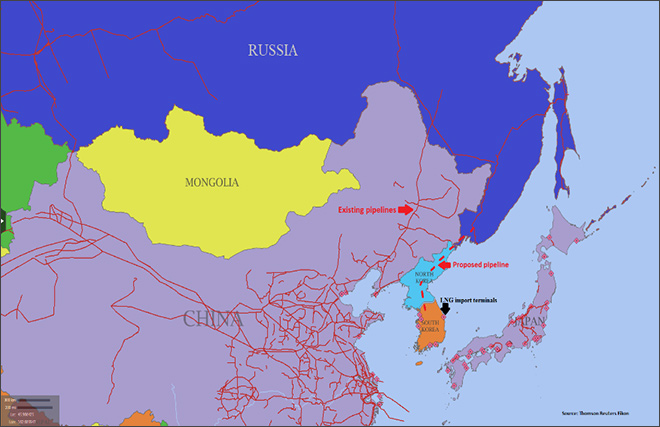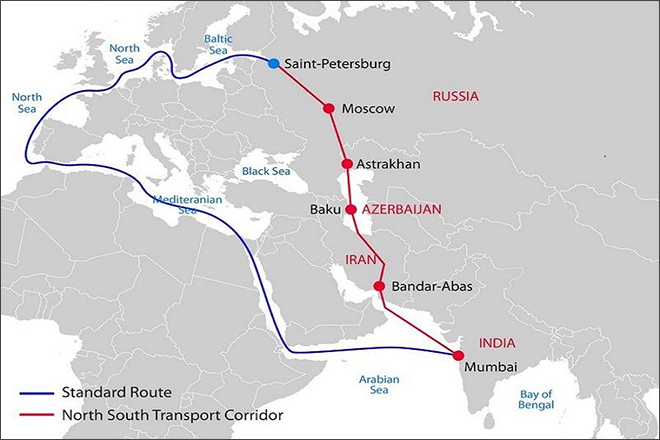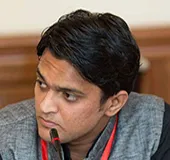-
CENTRES
Progammes & Centres
Location
 PDF Download
PDF Download 
Prathamesh Karle, “Russia’s Tilt towards Asia and its Implications for India”, ORF Issue Brief No. 287, April 2019, Observer Research Foundation.
Geographical transcontinentalism and dualism in Russia’s self-perception have played an important role in shaping its identity and engagement with Europe and Asia. Russia was geographically and politically associated with both continents in the days of the country being an empire; these associations continued even as it became a modern nation-state.
Historically, the seat of Russia’s imperial administration was located in Kiev (before its shift to Moscow in the 16th century), resulting in Russia’s active involvement in European politics. In the 19th century, the Russian Empire expanded its geographical boundaries up to the Pacific Ocean. Within its ambit were Eastern Siberia, Caucasus and Central Asia, which deepened its engagement with Asia. While incorporating new landmass, Russia embraced new people along with their cultures and religions. The subsequent imperial expansion of the Russian state incorporated substantial Muslim communities, most notably in the Caucasus and Central Asia.[1] During the latter stages of the Soviet era, Russia expanded more in Asia; this played an important role in shaping the identity of the Russian state and society. However, its political elites[2] continue to identify Russia as an integral part of the European political and cultural setup, considering its Asia policy to be only secondary.
This duality in Russia’s approach has a bearing on Asia, in general, and India, in particular. The old Soviet Union’s engagement with Asia benefitted India, both in terms of economic development and its interests in the international arena. Following the disintegration of the USSR, Russia attempted to integrate with the transatlantic political and economic system. However, this caused a rift within its political elites regarding the benefits of such a policy.
The resulting “Eurasianism vs. Atlanticism” debate articulates the dualism in Russia’s self-perception as either a European or an Asian entity. The Eurasian approach received a fillip in the post-Soviet phase, when engaging with Asia was a practical question, not a theoretical one. Led by the then Foreign Minister Yevgeny Primakov, Eurasianism re-emerged as Russia’s renewed de-ideologised outlook towards the world, particularly Asia.
While the concept of ‘Eurasianism’ is centuries old, it resurfaced as a foreign-policy option only in the post-Soviet era during the 1990s. This directional tilt was a result of its desire to benefit from the economic rise of Asia, and not only due to a rift with the transatlantic system.
It is important to first define the “tilt” that Russia has taken towards Asia, to understand the factors that are driving it. During the 1990s, the leaders of the post-Soviet Russia realised the importance of developing relations with its Asian neighbours for various reasons. It should not be perceived as Russia’s attempt at finding an alternative to the west, but rather as the political elite’s acknowledgment that Russia’s goals of domestic development and modernisation cannot be achieved without cooperating with the rising economies of Asia. “Thus, by pivoting to Asia, Moscow is not turning away from Europe, but giving Asia a level of attention commensurate with Russia’s practical interests and the realities of the 21st century.”[3]
The tilt is not merely a political dialogue, but a primacy accorded to the rising economic powers of the region and its various groupings. Russia’s Asia strategy has been to further its engagement with the region by forging new multilateral regional platforms and deepening engagement with the existing ones. According to Russian Foreign Minister Sergei Lavrov, “It is our clear commitment to ensure strength, stability, security and prosperity of the Asia Pacific. Intensification of the ‘Eastern’ track policy, development of regional bilateral ties, participation in inter-governmental structures are among Russia’s foreign policy priorities.”[4] In the last decade, Russia has deepened its engagement with countries such as China and Vietnam, along with multilateral platforms such as the Association of South-East Asian Nations (ASEAN), East Asia Summit, and the Asia Pacific Economic Cooperation (APEC). It also actively broadened the ambit of the Shanghai Cooperation Organisation (SCO) by adding India and Pakistan as members. Several neighbouring countries are in negotiations to become full members. Moreover, Russia has developed its relations with Pakistan to diversify its defence-exports policy and gain more leverage over the situation in Afghanistan.
Certain factors call for Russia’s increased involvement with Asia.
Map 1. Trans-Korea Pipeline

The realignment of Russia’s policy towards Asia presents opportunities for cooperation between India and Russia, diversifying and broadening the nature of their strategic partnership. However, it can also create some friction in the time-tested Russia–India bilateral ties.
There is some congruence in the way India and Russia perceive the world order. For one, both countries uphold the centrality of the United Nations in international affairs and reject the unipolar world order. India perceives Russia as a strategic partner in achieving a polycentric, stable and balanced world order.[21] For Russia, India is one of the most important financial and political powerhouses of the world.[22]
The renewed and broadened nature of Russia’s engagement with Asia will have several implications for India. These are the following—

Russia’s tilt towards Asia has been a gradual process and comes with limitations. Russia must avoid relying excessively on China in harnessing its Arctic energy. Currently, its relation with Japan is constrained due to Japan’s strategic relations with the US. This US factor will continue to impede the growth and potential of Russia–Japan relations. Asia is not yet in a position to completely replace Europe in terms of the volume of energy imports from Russia, due to geographical and political constraints as well as competition from the Gulf countries and the US. However, while Russia’s economic engagement with Europe will continue, political distrust may also be prevalent. This could influence Russia to further its engagement with Asia, leading to the establishment of new institutions and the redefining of the existing ones. The success or failure of Russia’s tilt towards Asia thus depends on the extent to which it is able to align Asian institutions to its interests.
Russia is poised to play an increasingly active role in Asian politics in the coming decades, since Asia plays a vital role in Russia’s domestic development and technological modernisation. Moreover, Asia’s geopolitical significance allows Russia to re-emerge as an active global player. As India diversifies its defence imports by importing from countries such as France, Israel and the US, Russia will also pursue its national interests and extend its cooperation with Pakistan and China. As traditional partners, both India and Russia must maintain a favourable balance of power in Asia. Russia’s renewed outlook towards Asia provides this necessary opportunity, to not only redefine the bilateral relations but also provide a basis for cooperation on regional and global levels.
Prathamesh Karle is a research scholar at the Centre for Central Eurasian Studies, University of Mumbai.
[1] Roland Dannreuther, “Russian discourses and approach to Islam and Islamism,” in Russia and Islam: State, Society and Radicalism, Dannreuther Roland and March Luke (New York: Routledge, 2010), 9.
[2] The former Russian Foreign Minister Igor Ivanov, in his book The New Russian Diplomacy, states, “… it is undeniable that the European vector has played a lead role in determining Russia’s foreign policy for the past several centuries. In fact, Russia did not just meet Europe halfway, but acted as an integral part of Europe’s system of foreign relations.”
[3] Alexander Lukin, “Russia’s Pivot to Asia: Myth or Reality?” Strategic Analysis 40, no. 6 (2016): 573–89, DOI: 10.1080/09700161.2016.1224065.
[4] Sergey Lavrov, “Towards Peace, Stability And Sustainable Economic Development in the Asia Pacific Region”, Ministry of Foreign Affairs, Russia, 2016.
[5] Eurostat, European Commission, accessed 9 November 2018.
[6] Henry Foy, “Russia’s gas exports to Europe rise to record high”, Financial Times, Moscow, 3 January 2018, accessed 9 November 2018.
[7] US Energy Information Administration, “Russia exports most of its crude oil production, mainly to Europe, 14 November 2017, accessed 9 November 2018.
[8] Alec Luhn and Terry Macalister, “Russia signs 30-year deal worth $400bn to deliver gas to China,” The Guardian, 21 May 2014, accessed 9 November 2018.
[9] “Gazprom, South Korea resume talks on construction of gas pipeline through North Korea,” TASS, 15 June 2018, http://tass.com/economy/1009657.
[10] “Address by President Moon Jae-in at the State Duma of Russia,” Briefings and Speeches, Office of the President, 21 June 2018.
[11] “Ice-Breaking LNG Carrier ‘Vladimir Rusanov’ for Yamal LNG Project Started the First Loading Operation in the Yamal LNG Plant at Sabetta Port,” Press Release, Mitsui O.S.K. Lines, 29 March 2018, accessed 9 December 2018.
[12] Decree of the President of Russia, Executive Order of the President of the Russian Federation, Eastern Economic Forum, Moscow, No. 250, 19 May 2015, accessed 10 November 2018.
[13] Sergei Karaganov, “From East to West or Greater Eurasia,” Russia in Global Affairs, Moscow, 25 October 2016, accessed 9 November 2018.
[14] Li Xiaokun, “China Russia sign border agreement,” China Daily, 22 July 2008, accessed 30 March 2019.
[15] Especially in the backdrop of the issue in Afghanistan and the growing involvement of China in developing Russia’s Arctic energy deposits.
[16] “Москва призывает Сеул взвесить возможные последствия размещения комплексов ПРО США,” ITAR TASS, 24 July 2014, accessed 29 March 2019.
[17] Henry Foy, “Can Russia stop using US dollar?” Financial Times, 3 October 2018, accessed 14 January 2019.
[18] Ibid.
[19] “Russia inked S-400 deal with India in roubles, says deputy PM, Military and Defense,” TASS, 31 October 2018.
[20] “Russia, China deliberate on teaming up to buck US sanctions,” TASS News Agency: Business and Economy, 28 January 2019, accessed 29 January 2019.
[21] Nirmala Joshi and Raj Kumar Sharma, “India–Russia Relations in a Changing Eurasian Perspective,” India Quarterly 73, no. 1 (March 2017): 36–52, DOI: 10.1177/0974928416683056.
[22] Foreign Minister S. Lavrov’s interview with Channel 4, Moscow, 29 June 2018, Ministry of Foreign Affairs of Russia, 8 November 2018.
[23] Dipanjan Roy Chaudhary, “India signs MoU with Russia to fast-track North-South corridor,” ET Bureau, 5 February 2019.
[24] “Closed bloc arrangements will not help in Asia-Pacific region: Russia,” Business Standard, 11 December 2017, accessed 30 March 2019.
[25] “Second round of the Moscow format consultations on Afghanistan,” Briefing by Foreign Ministry Spokesperson Maria Zakharova, Ministry of Foreign Affairs, Russia, 8 November 2018, accessed 25 November 2018.
[26] “Comment by the Information and Press Department of the Russian Ministry of Foreign Affairs regarding the meeting in Moscow of representatives of the leading political forces of Afghanistan,” Ministry of Foreign Affairs, Foreign Policy, 7 February 2019.
[27] Dmitri Trenin, “Russia’s Evolving Grand Eurasia Strategy; Will it work?” Carnegie Moscow Center, 20 July 2017, accessed 9 November 2018.
The views expressed above belong to the author(s). ORF research and analyses now available on Telegram! Click here to access our curated content — blogs, longforms and interviews.

Prathamesh Karle is a research scholar at the Centre for Central Eurasian Studies University of Mumbai.
Read More +